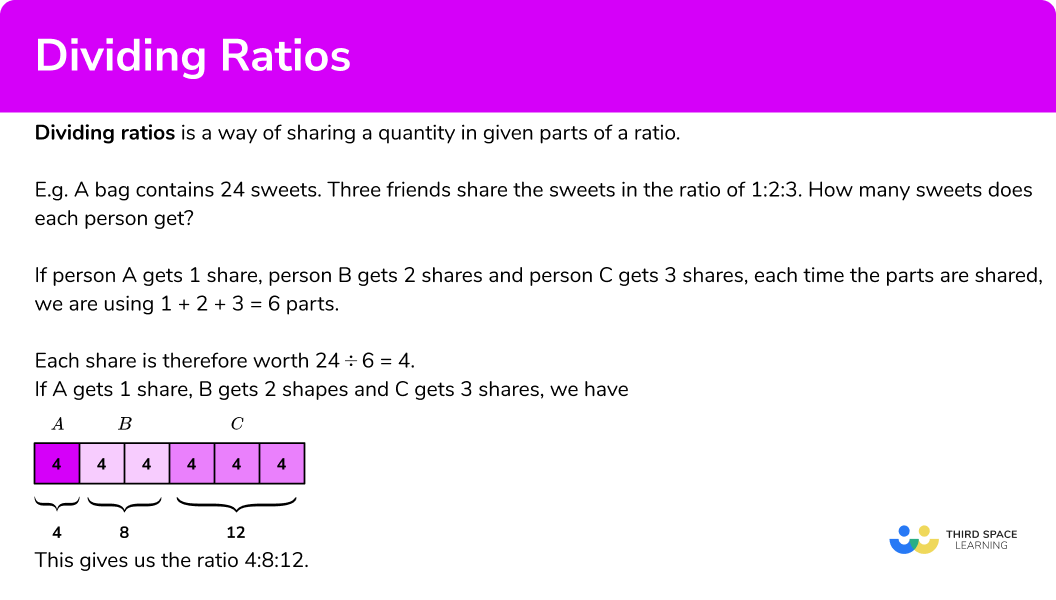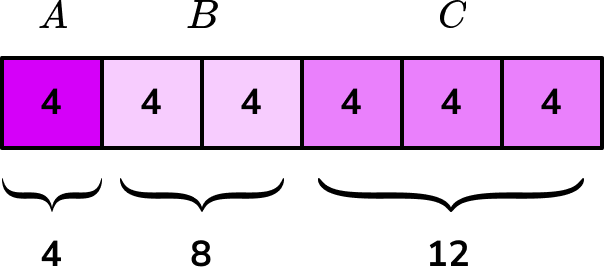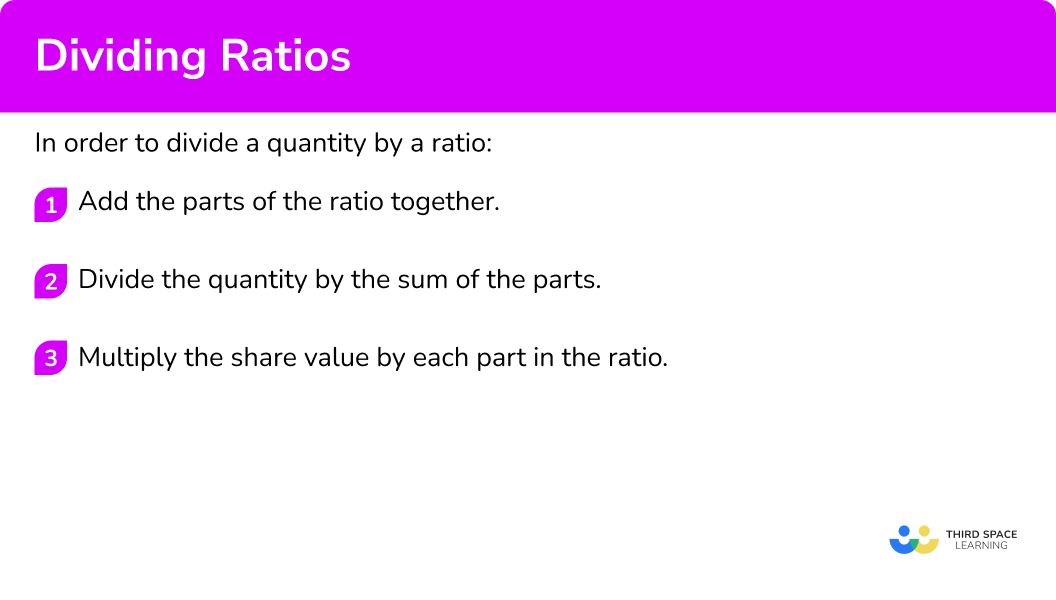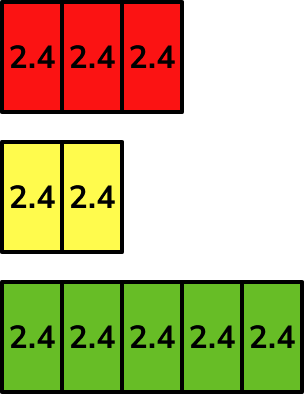GCSE Tutoring Programme
Our chosen students improved 1.19 of a grade on average - 0.45 more than those who didn't have the tutoring.
In order to access this I need to be confident with:
Arithmetic Improper fractions and mixed numbers Converting fractions, decimals and percentages Equivalent fractionsThis topic is relevant for:

Dividing Ratios
Here we will learn about dividing ratios, including how to share a quantity in a given ratio and real life ratio problems.
There are also ratio worksheets based on Edexcel, AQA and OCR exam questions, along with further guidance on where to go next if you’re still stuck.
What is dividing ratios?
Dividing ratios is a way of sharing a quantity in given parts of a ratio.
These questions can get quite wordy as they can apply directly to real life problems, usually involving money or food. This means that it is likely that you will have to draw out the relevant information from the question. You can also expect your answers to be integers (whole numbers), decimals, fractions or mixed numbers.
Share into a ratio
For example,
Share the amount £10 in the ratio 2:3.
Here, the quantity is £10, which is being shared in the parts of the ratio, 2 and 3. Our aim is to find an equivalent ratio where the sum of the ratio parts is equal to 10.
Currently we know the following facts,
The quantity = £10
The ratio = 2:3

We need to determine how many shares there are in the ratio overall.
We do this by adding the parts of the ratio together, 2+3=5 shares.
We have £10 being split into 5 shares, and so we divide the quantity by the total amount of shares of the ratio 10 \div 5=2.
We call this the value of one share.
So each share is worth £2.

If there are 2 shares in the first part of the ratio, and each share is £2, we multiply these values together to get the amount for that part of the ratio 2 \times £2=£4.
Repeating this for the second part of the ratio, we get 3 \times £2=£6.

The solution is £4:£6 (in that order).
To check your solution, add the final parts of the ratio together. If it is correct, this total should match the original quantity £4+£6=£10. This is correct.
Note: Don’t be tempted to write your answer in its simplest form – you are finding an equivalent ratio where the parts total the quantity. That being said, it is a good way to check if your solution is correct. 4:6 does simplify to 2:3 , the original ratio.
What is dividing ratios?

Bar modelling
The example above shows the use of bar modelling in how to share a quantity in a given ratio. Let’s have a look at another example using a three part ratio.
For example,
A bag contains 24 sweets. Three friends share the sweets in the ratio of 1:2:3. How many sweets does each person get?
If person A gets 1 share, person B gets 2 shares and person C gets 3 shares, each time the parts are shared, we are using 1+2+3=6 parts.
Each share is therefore worth 24 \div 6=4.
If A gets 1 share, B gets 2 shapes and C gets 3 shares, we have

This gives us the ratio 4:8:12.
How to divide a quantity by a ratio
In order to divide a quantity by a ratio:
- Add the parts of the ratio together.
- Divide the quantity by the sum of the parts.
- Multiply the share value by each part in the ratio.
Explain how to divide a quantity by a ratio


Sharing in a ratio worksheet / Dividing ratios worksheet

Get your free sharing in a ratio worksheet of 20+ questions and answers. Includes reasoning and applied questions on dividing ratios.
DOWNLOAD FREE
Sharing in a ratio worksheet / Dividing ratios worksheet

Get your free sharing in a ratio worksheet of 20+ questions and answers. Includes reasoning and applied questions on dividing ratios.
DOWNLOAD FREERelated lessons on ratio
Dividing ratios is part of our series of lessons to support revision on ratio. You may find it helpful to start with the main ratio lesson for a summary of what to expect, or use the step by step guides below for further detail on individual topics. Other lessons in this series include:
Dividing ratios examples
Example 1: standard question
Share the amount £120 in the ratio 1:4.
- Add the parts of the ratio together.
2Divide the quantity by the sum of the parts.
120 \div 5=243Multiply the share value by each part in the ratio.
24 \times 1=£24 24 \times 4=£96Answer,
£24:£96 .
Example 2: ratio sharing problem
A bag of sweets contains 600 sweets. The sweets were divided between boys and girls in the ratio 1:2. If there are 25 girls, how many sweets did each girl receive?
Add the parts of the ratio together.
So we have the amount of 600 and the ratio 1:2.
1+2=3.
Divide the quantity by the sum of the parts.
Multiply the share value by each part in the ratio.
400 sweets were given to the 25 girls so
400 \div 25=16 .
Answer,
16 sweets.
Example 3: three part ratio
30 glue sticks were divided in 3 groups in the ratio 3:2:1. Calculate how many glue sticks each group received.
Add the parts of the ratio together.
Divide the quantity by the sum of the parts.
Multiply the share value by each part in the ratio.
Answer,
15:10:5 .
Example 4: large quantities
A garage sells hatchbacks and SUVs. 1600 cars were sold in one year at the garage, in the ratio of 3:2 of hatchbacks to SUVs. How many hatchbacks were sold?
Add the parts of the ratio together.
Divide the quantity by the sum of the parts.
Multiply the share value by each part in the ratio.
Answer,
960 hatchbacks.
Example 5: find one amount
Concrete is made from 1 part cement, 2 parts sand and 3 parts gravel. If Jarred wants to make 900kg of concrete, how much sand does he need?
Add the parts of the ratio together.
Divide the quantity by the sum of the parts.
Multiply the share value by each part in the ratio.
Answer,
300kg of sand.
Example 6: recipe
A cocktail is made from mixing pineapple juice, orange juice, and sparkling water in the ratio 300ml:700ml:0.5l. How much of each quantity would be needed to make 6l of cocktail?
Add the parts of the ratio together.
All the units must be the same in the ratio and so 0.5l = 500ml sparkling water and so the ratio of pineapple to orange to sparkling water is 300:700:500. This means the total is equal to
300+700+500=1500ml=1.5l .
Divide the quantity by the sum of the parts.
Multiply the share value by each part in the ratio.
Answer,
1200ml of pineapple juice,
2800ml of orange juice,
2000ml of sparkling water.
Or
1.2l of pineapple juice,
2.8l of orange juice,
2l of sparkling water.
Example 7: bar modelling
The bar model below shows the ratio of the length of time the red, yellow and green traffic lights are on during one sequence.

In one day, how many hours is each light on?
Add the parts of the ratio together.
Adding up the number of shares in the bar we have 3+2+5=10 .
Divide the quantity by the sum of the parts.
A day has 24 hours and so 24 \div 10=2.4 .
So each share represents 2.4 hours.
Multiply the share value by each part in the ratio.
Looking at each colour, we have

Red = 2.4 \times 3=7.2 hours
Yellow = 2.4 \times 2=4.8 hours
Green = 2.4 \times 5=12 hours
Answer,
Red = 7.2 hours ( 7 hours 12 minutes),
Yellow = 4.8 hours ( 4 hours 48 minutes),
Green = 12 hours.
Example 8: given one part of the ratio
Maxine and Niamh share some money in the ratio 3:5. Nimah receives £45. How much money was shared?
Add the parts of the ratio together.
Adding up the number of shares in the bar we have 3+5=8 .
Divide the quantity by the sum of the parts.
We cannot do this. We have been told that 5 parts are £45. So we divide £45 by 5 to find the value on each share.
45 \div 5=9
So each share represents £9.
Multiply the share value by each part in the ratio.
We can work out Maxine’s part,
3 \times 9=£27 .
Then we can work out the total money,
£27+£45=£72 .
So, £72 was shared between Maxine and Niamh.
Here is the question as a bar model.

Common misconceptions
- Ratios and fractions confusion
Take care when writing ratios as fractions and vice-versa. Most ratios we come across are part:part. The ratio here of purple:pink is 1:2. So the fraction which is purple is \frac{1}{3} (not \frac{1}{2} ).

- Dividing the ratio by each part
As you need to divide something, it is incorrectly assumed that the amount is divided by each part of the ratio separately. Take for example “divide £120 in the ratio 2:3 ”. The answer is created by dividing £120 by 2, and then £120 by 3 to get £60:£40.
This does not make sense as the answer ratio is not equivalent to the original ratio. Instead the amount is divided by the sum of the parts in the ratio 120 \div (2+3)=120 \div 5=£24 , and then multiplied by each part in the ratio 24 \times 2=£48, \ 24 \times 3=£72.
- Mixing units
Make sure that all the units in the ratio are the same. For example, in example 6 , all the units in the ratio were in millilitres. We did not mix ml and l in the ratio.
- What numbers to use
Knowing what each number represents is very important for these types of questions. First we use the parts in the ratio ( 1:2 means 1+2=3 so we have a total of 3 parts in the ratio). We then divide the quantity given by the number of parts.
The unit will therefore be the same as this calculates the value of each part or share. We then multiply the value per share by each value in the ratio, which will have the same unit as the original amount. If you get confused, write the units down on each line of working.
- Counting the number of parts in the ratio, not the total number of shares
The ratio 5:4 has 9 shares, and 2 parts. This is because the ratio contains 2 numbers but the sum of these parts (the number of shares) is 5+4=9. You need to find the value per shape, so you need to use the 9 shares in your next line of working.
- Simplifying the answer
When sharing a quantity in a given ratio, you are finding an equivalent ratio. You do not need to simplify the answer.
Practice dividing ratios questions
1. There are 10 boys and 9 girls. Each person is to receive the same amount from £380. How much do all the boys, and all the girls receive? Express your answer as a ratio.




2. A company made £72000 profit. It divides the profit between its employees (E) and its shareholders (S). The shareholders receive 55\% of the profit. Calculate how much money the employees receive, giving your answer as a ratio in the form E:S.




3. A swimming club is tracking its members. They have 7668 members in the ratio of 2:3:4 (Males : Females : Children). Calculate how many people there are in each category.




4. A farm is processing cherries into two categories, stalk attached or stalk not attached. In one season, the farm produces 150,000 cherries of which the ratio of those with and without stalks is 8:7 respectively. How many cherries are in each category? Express your answer as a ratio.




5. Air is made up of nitrogen, oxygen, and other gases in the ratio 78:21:1. A 5l balloon is filled with air. How much oxygen is in the balloon?




The amount of oxygen is 1050ml or 1.05l.
6. A recipe for shortbread consists of plain flour, butter and caster sugar in the ratio 3:2:1. How much plain flour would I need for 900g of shortbread?




Dividing ratios GCSE questions
1. Purple paint is sold in 18l pots. The colour ratio of paint within the pot is 8:3:1 of white to red to blue.
If 5 pots of purple paint were ordered, how much red paint was used to make the purple paint?
(3 marks)
(1)
60 \div (8+3+1)=60 \div 12=7.5 l(1)
7.5 \times 3=21.5l(1)
2. (a) A soap is made from 2 ingredients A and B in the ratio 5:11. If I have 1.5l of ingredient A , how much of ingredient B would I need to make the soap?
(b) The soap is dispensed into 400ml bottles for sale. How much of ingredient A is in one of these bottles?
(4 marks)
(a)
1.5 \div 5=0.3l \ (300ml)
(1)
0.3 \times 11=3.3l \ (3300ml)(1)
(b)
400 \div (5+11)=25ml
(1)
25 \times 5=125ml of ingredient A .
(1)
3. Grace and Hugh share some money in the ratio of 10:7. Grace receives £66 more than Hugh. How much money did Hugh receive?
(3 marks)
(1)
7 \times 22(1)
=£154(1)
4. Pat and Quin share some sweets.
Pat receives 16 sweets and Quinn receives 20 sweets.
Express the ratio of Pat’s sweets to Quinn’s sweets.
Give your answer in its simplest form.
(2 marks)
(1)
4:5(1)
Learning checklist
You have now learned how to:
-
Divide a given quantity in 2 parts in a given part:part ratio
-
Express the division of a quantity in 2 parts as a ratio
The next lessons are
Still stuck?
Prepare your KS4 students for maths GCSEs success with Third Space Learning. Weekly online one to one GCSE maths revision lessons delivered by expert maths tutors.

Find out more about our GCSE maths tuition programme.